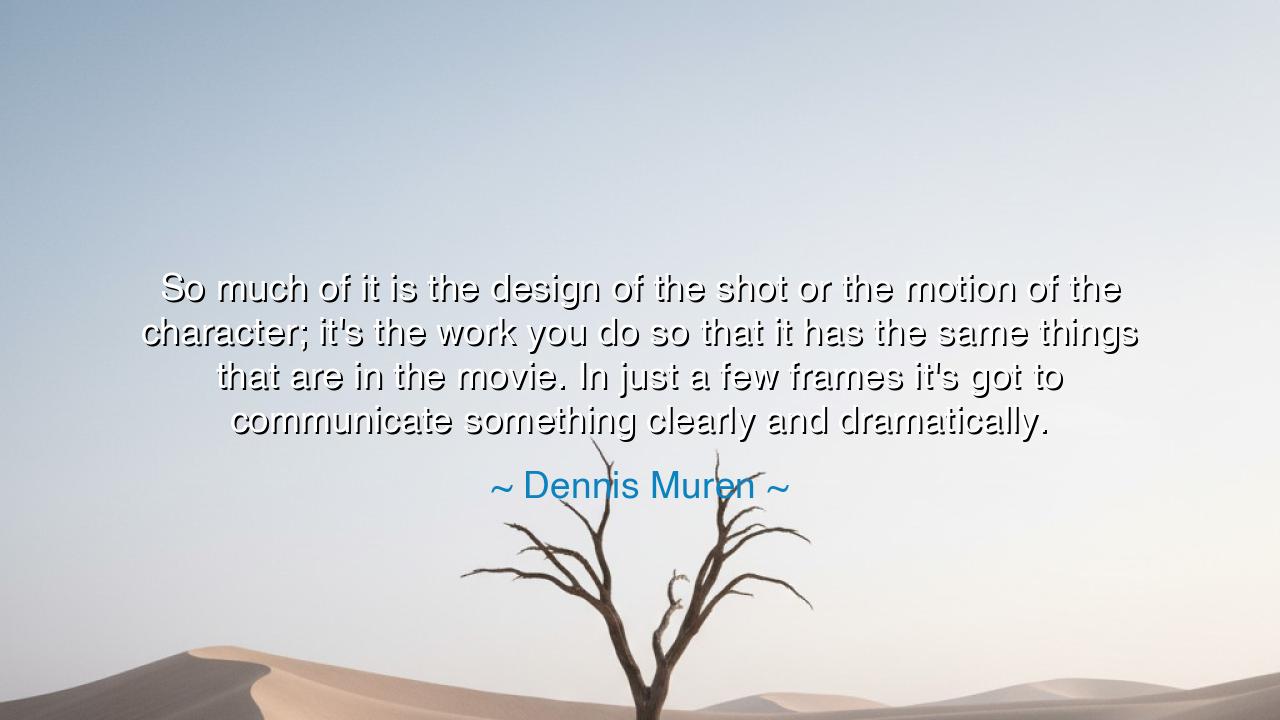
So much of it is the design of the shot or the motion of the
So much of it is the design of the shot or the motion of the character; it's the work you do so that it has the same things that are in the movie. In just a few frames it's got to communicate something clearly and dramatically.






“So much of it is the design of the shot or the motion of the character; it's the work you do so that it has the same things that are in the movie. In just a few frames it's got to communicate something clearly and dramatically.” – Dennis Muren
Hear these words, O seekers of art and meaning, spoken by Dennis Muren, the master of visual sorcery and illusion, whose hand helped shape the dreams of modern cinema. From the cosmic battles of Star Wars to the living wonders of Jurassic Park, his craft is not merely technical—it is a form of creation itself. When he declares that “in just a few frames it’s got to communicate something clearly and dramatically,” he speaks of a truth that transcends the art of film. He reveals the eternal law of storytelling: that clarity, emotion, and purpose must live in every moment, for even the smallest fragment can contain the soul of the whole.
For Muren, design is not a matter of ornament or complexity—it is intent made visible. To design the shot, to craft the movement of a character, is to capture in seconds what the heart of the story demands. Every gesture, every light, every shadow must serve the spirit of the tale. Just as the poet labors over a single word to convey truth, so too does the visual artist labor over a single frame, knowing that within it lies the weight of emotion and meaning. The ancients knew this wisdom well: the sculptor Phidias, when carving the friezes of the Parthenon, worked upon details no mortal eye would ever see, for he believed the gods themselves would behold them. So too must the artist of today honor each frame, each motion, with the same reverence—for in the smallest act lies the reflection of eternity.
The words of Muren echo the discipline of focus and purpose. He teaches that art is not built upon abundance, but upon precision. It is not enough for a scene to exist—it must speak, even when silent. The flicker of light across a character’s face, the rhythm of a camera’s movement, the tension in a pause—these are not accidents. They are the architecture of emotion. As the master says, “the work you do” is to ensure that every fragment “has the same things that are in the movie.” In other words, the smallest part must hold the essence of the whole—just as each drop of the ocean reflects the sky above it.
Consider the example of Muren’s work on E.T. the Extra-Terrestrial. The creature itself was a marvel of design, yet its magic did not come from mechanics alone. It came from how it moved, how it gazed, how the light touched its face. In a single shot—E.T.’s glowing finger reaching toward a child—there is no dialogue, no spectacle, only motion and meaning intertwined. Yet it tells an entire story: of loneliness, of wonder, of connection across worlds. This is what Muren speaks of. In a few frames, the artist must convey what words cannot: the beating heart of the story.
And so, his teaching reaches beyond film, beyond art, into the realm of living itself. For life, too, is composed of moments—frames of time in which we communicate who we are. Our gestures, our silences, our actions—these are the shots of our existence. Just as Muren urges the artist to craft each frame with clarity and intent, so too must we live each moment with awareness and purpose. Let no word or deed be empty. Let every choice reflect the story we wish to tell.
Muren’s wisdom also reminds us of discipline and humility. The great artist must labor unseen, shaping meaning that others may feel but never notice. The power of his craft lies in restraint—knowing when to hold back, when to let silence speak, when a subtle motion can move mountains of emotion. The ancients called this virtue sophrosyne—the harmony of control, balance, and grace. The greatest creators, like the greatest leaders, understand that true mastery is not the multiplication of detail, but the distillation of truth.
So, O student of art and life, take this lesson to heart: everything you do, no matter how small, must carry the weight of meaning. Whether you create, speak, or act, do so with the intent to communicate something true and human. Let each moment—each “frame”—express what your soul wishes the world to know. For clarity is the breath of greatness, and purpose the heartbeat of creation.
And thus, as Dennis Muren teaches, remember that the universe is built not of grand gestures but of tiny, perfect motions. The story of life, like the story of film, is told in fragments—moments of love, courage, sacrifice, and grace. Craft them well, live them fully, and in those fleeting frames, let eternity find its reflection.






AAdministratorAdministrator
Welcome, honored guests. Please leave a comment, we will respond soon